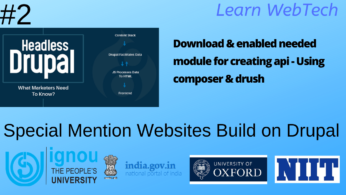Table of content
- What is Drupal Headless CMS ?
- Drupal headless architecture
- Why Drupal headless CMS ?
- Drupal vs headless cms | Drupal headless vs decoupled
- Which Decoupled Drupal Solution is Best for You?
- Why headless CMS is growing?
- Is headless Drupal suited for any kind of project?
- Benefits of Drupal as a headless CMS | Benfits of drupal decoupled cms
- List of websites which developed using headless drupal.
- drupal headless tutorial | drupal 9 headless tutorial | drupal decoupled CMS tutorial step by step
- Conclusion
What is Drupal Headless CMS?
Drupal can manage both – the back-end content management as well as the front-end rendering of content. Drupal CMS having lots of free themes and modules which can deliver a rich user experience to the end user but when it comes down to instantaneous responses for a request, delivering content seamlessly in different interfaces, it does fall short. In a decoupled Drupal architecture, instead of the Drupal’s theme layer, a client-side framework like AngularJS, React or Backbone.JS is used. A user request does not have to be processed by the server all the time, which can drastically improve the speed and UX of your Drupal website.
Drupal is the end-to-end solution for serving users with pages. It is used to create store and display content to the end-user. In a headless approach adding and storing are still done on Drupal but displaying is not
Headless Drupal is an approach to develop Drupal websites using an API, in which Drupal serves as the backend content repository. The frontend is built in different technologies and communicates with Drupal via an API.
Here Drupal is responsible for storing content and provided data using API to the frontend technologies e.g. backbone.js, react.js etc. And this is responsible for rending layouts and presentation.
In other words, We can say that, a headless Drupal website sends out data in HTTP/JSON formats via API. A powerful front-end UI framework renders this data and delivers the web page quickly.
Drupal headless architecture

Why Drupal headless CMS?
In the above diagram, we can see that Drupal used as the backend system, which is responsible content part only. The frontend, which the client sees (users sees), is separate from Drupal. That is where the headless name comes from – Drupal does not have the top layer anymore (the head), but only exposes the APIs which the frontend consumes and uses as content sources.
Let’s understand by an example. frontend means head here which is not in Drupal event it’s in some other frontend frameworks e.g., Angular, react. And data consumed from Drupal using API, we can say that it’s content part, mean head in some other technology and content in Drupal, so that’s why Drupal called as headless Drupal.
Drupal vs headless cms | Drupal headless vs decoupled
As per Acquia, let’s first understand what is the difference between a Traditional CMS, Headless CMS, and a Decoupled CMS?·
Traditional CMS: Users create content through a CMS editor and store it in a database (the back end).
That content is then served into a frontend rendering layer that is tightly coupled to the back end mean backend and frontend both managed by CMS.
Headless CMS: Users create content through a CMS editor and store it in a standalone database fronted.
by APIs. The content is retrieved by an entirely separate frontend rendering layer via those APIs.
Decoupled CMS: Blends the traditional and headless CMS. Users create content through an CMS editor and store it in a database. The content can be served flexibly either through the existing frontend rendering layer or retrieved by an entirely separate frontend rendering layer via APIs.
Following requirements, a decoupled or headless architecture may not be a great fit.
- Full-fledged editorial experience for your content team
- Frequent needs to manipulate display and layout
- End-to-end preview of the application prior to launch
- Minimal resources needed to maintain your digital application infrastructure
Which Decoupled Drupal Solution is Best for You?
Before selecting a decoupled architecture, it is important to understand what you are asking of your application. This architecture provides benefits in frontend compatibility with new channels, Realtime data updates and timetomarket.
However, you are trading off some of the key benefits of a robust CMS like endtoend preview, design templates, and the reduction of complexity to manage multiple technologies. Even with the tradeoffs, there are some key use cases where decoupled is growing in popularity because the advantages outweigh the disadvantages.
If you want to adopt modern front-end technologies that Drupal cannot provide your need, then a powerful front-end framework like React JS or Angular JS. With a headless Drupal approach, you can have all of this and still maintain your robust backend Drupal CMS.
With the Headless Drupal architecture, you can “Write once and publish everywhere”. Mean you can create content in CMS and provide that to the frontend technology using Rest API. So, system allows content editors, marketers and business owners to create content once and deliver it to multiple interfaces seamlessly as per requirement, it can be different layout of same content without effected the actual content in CMS.
Headless Drupal allows front-end developers to have full control over the presentation (UI design and UX) of the website. The combination of a great client-side framework and a seasoned front-end developer can get you a website with a rich, faster, application-like user-experience, and seamless interactivity.
Integrating with third party applications is easier and more efficient with a headless Drupal model.
Both the front-end and back-end developers can work independently which can lead to efficient and speedy delivery of a project.
Why headless CMS is growing?
The headless CMSes space is exploding in recent years. This is mostly due to 2 reason:
- Uses of javascript frameworks which allow for the creation of superb user experiences. For example React, Angular are great in building these, but they require a backend for content storage and backend is drupal which is best CMS forever.
- The publish once, push everywhere idea which is adopted along with the rise of the Omnichannel brand presence and the advent of Digital Experience Platforms. Content now has to be distributed via all the channels in which Drupal is present.
Is headless Drupal suited for any kind of project?
Decoupling Drupal can help you achieve your goals of an uninterrupted and application-like user- experience, it might not be a good fit for everyone. Because a headless infrastructure is more complex than a traditional Drupal website. This can cause additional difficulties and can increase costs. Deciding on a headless, you should consider whether the benefits outweigh the costs
Websites like News sites or Blogs that don’t much user interactivity, will not benefit from decoupling their Drupal website.
If budget is an issue you need to keep in mind about the price you will have to shell out for experienced front-end developers.
there are 2 separate components (frontend and backend) and these have to be developed in coordination. Quite often, there will be separate developers or teams (backend and frontend) working on the website. Sometimes these are 2 different companies. This requires coordination and much more communication because data models have to be agreed, endpoints created and tested. It is true that in Drupal many of these might be available out of the box, but most probably there will be requirements for some custom ones.
Benefits of Drupal as a headless CMS | Benfits of drupal decoupled cms
There are lots of benefits using Drupal as headless CMS, some of them are below.
Faster editing experiences: Traditional CMS architectures have to spend resources on content editing, and content rendering. A headless CMS has an advantage over traditional alternatives because it doesn’t have to deal with the rendering side of things. That’s left to other more specialized parts of your stack.
front-end flexibility: With Drupal as your headless CMS, developers can create any front-end experience using any frontend technology, tools.
Create once, publish everywhere: A headless CMS like Drupal enables marketers and publishers to create content and deliver it to the vast and growing list of channels that aren’t tied to a website.
Maintain a single source for content: Headless Drupal enables all content to be kept in a single repository, simplifying version control, brand management and content organization.
Use an API-first approach: With Acquia and Drupal as your headless CMS, developers can use a set of APIs for data consumption rather than building an entire stack.
Accelerate production timelines: By enabling front-end and back-end teams to work concurrently, headless Drupal may allow applications to move through development stages more quickly.
Developers Flexibility: Drupal’s headless CMS allows developers who are experienced in other front-end platforms to work with their preferred tools.
List of websites which developed using headless drupal.
Click here to list many websites using headless.
I worked on below projects or many more as headless drupal CMS
Drupal headless tutorial | drupal 9 headless tutorial | drupal decoupled CMS tutorial Step by Step
- Install Drupal 9 using composer | Install drupal 9 using composer with lando
- Install drupal 9 module using composer
- drupal 9 custom module | drupal 9 custom module development
- Create Content type in Drupal 9
- Create Custom Rest API in Drupal 9 | Create Custom Rest API in Drupal 8
Conclusion
Headless CMS is nothing but a response to the current evolution of the content-management and content-exploitation paradigms. Being able to send and render content on many platforms at the same time is becoming a requirement for any business and making use of that data in other forms other than simple presentation is also becoming more common every day.
Feel free to leave a comment below if there are any questions, I will try to answer that quickly.
Thanks for reading.

